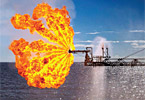

GULF OF MEXICO
While the Gulf Of Mexico was undoubtably a disaster in terms of human, ecological, business reputation and financial, it was also an event that caused the utterly wasteful destruction of valuable oil reserves. The oil that was leaking into the sea was being collected by skimmers and then processed to separate it from the water. Where oil ended up on land, it was collected together with contaminated material for ultimate burial. The oil and gas that was being collected by the LMRP Cap were processed on board the Q4000 where the gas was flared and the oil either stored for transfer or it too was flared.
 This flaring process was the cringeingly wasteful act of just burning the oil and gas with as little pollution as possible. For oil, this was achieved
using a Sclumberger EverGreen burner. It might have been green in terms of pollution but its purpose was far from green, viz., to burn large
quantities of oil products
as efficiently as possible to provide "
an efficient and cost-effective alternative to oil storage". It can burn up to 15,000 barrels of
oil per day and was used to flare about 8,000 barrels per day at peak times. Each barrel had an equivalent energy content of 1,700kWh[1], so
that's about 13,600MWh flared per day. A person living in Europe consumes about 125kWh of energy per day. This covers all activity: growing
food, transport, heating, clothes, etc. The oil flared each day would provide enough energy to sustain over 100,000 people.
This flaring process was the cringeingly wasteful act of just burning the oil and gas with as little pollution as possible. For oil, this was achieved
using a Sclumberger EverGreen burner. It might have been green in terms of pollution but its purpose was far from green, viz., to burn large
quantities of oil products
as efficiently as possible to provide "
an efficient and cost-effective alternative to oil storage". It can burn up to 15,000 barrels of
oil per day and was used to flare about 8,000 barrels per day at peak times. Each barrel had an equivalent energy content of 1,700kWh[1], so
that's about 13,600MWh flared per day. A person living in Europe consumes about 125kWh of energy per day. This covers all activity: growing
food, transport, heating, clothes, etc. The oil flared each day would provide enough energy to sustain over 100,000 people.
[1] Barrel of oil equivalent - Wikipedia.